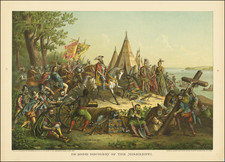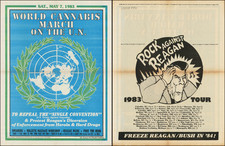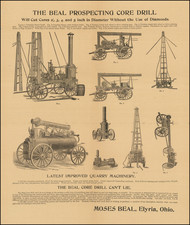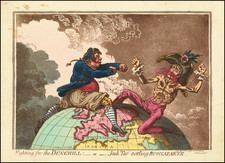Kellogg's Heath Crusade in Color Lithography
This intriguing set of five color-lithograph charts, created by Dr. J. H. Kellogg, of Kellogg's Corn Flakes fame, forms a remarkable tableau of the wide-ranging interests and expertise of one of the most influential figures in health reform during the late 19th century. Published in 1886 under the encompassing title, "Anatomy, Physiology and Hygiene," these educational charts encapsulate the intersection of medical knowledge, popular health movements, and socio-political beliefs of the period.
John Harvey Kellogg, often styled the inventor of flaked cereals, was physician‐in‐chief of the Battle Creek Sanitarium in Michigan for over six decades. Highlighting his prominence, Kellogg enjoyed membership in several respected scientific associations, including the American Public Health Association, Societe D' Hygiene de France, the American and British Associations for the Advancement of Science, and the American Society of Microscopists. His extensive published works, including textbooks on physiology and hygiene, established him as a key figure in the development of modern health and wellness practices in the United States. Kellogg was not just a physician; he was also an ardent advocate for health reform, particularly through his promotion of a vegetarian diet, exercise, and the application of "biologic living," principles which were sometimes dismissed as eccentricities or quackery by his contemporaries.
Styled by Kellogg himself as a Pictorial Encyclopedia of Hygiene and Temperance, these color charts go far beyond conventional human anatomy diagrams - they stand as striking visual evidence of Kellogg's integration of scientific knowledge and health advocacy. The charts likely grew out of Kellogg's experience in training nurses in his Battle Creek Sanitarium's Nurses' Training School (established in 1884). Each poster focuses on a different aspect of human physiology — from the nervous and respiratory systems to the skeletal and muscular structures. Detailed and meticulously labeled, the posters served both as educational tools for a growing public interest in health and wellness and as persuasive pieces aimed at shaping behaviors and beliefs around health practices. The five posters offered here are as follows:
- Effects of narcotics and stimulants.
- Effects of alcohol upon the human stomach - Temperance statistics.
- The nervous system - The special senses - The respiratory system.
- The digestive system - The circulatory system.
- The skeleton - The muscles - The tissues.
Our five charts are copyrighted 1886, and the only other set we can locate, at Andrews University, is comprised of the same five charts. By 1889 Kellogg was advertising a set of ten "Chromo-Lithographic plates, each 32 x 48 inches," intended for teaching physiology and hygiene. According to Kellogg's advertisement text: "The author of these charts has for years been engaged in teaching physiology and hygiene in the class room and by popular lectures, and has endeavored to fill the gap in means of pictorial illustration by blackboard sketches and charts specially prepared for his own use....he has selected from among the designs which have thus grown our of his practical experience in teaching these subjects... and now presents them in this form... A number of skilled artists were employed for several months in perfecting the designs and coloring, and no expense has been spared to make the charts both scientifically accurate and thoroughly artistic." The complete set of ten charts comprised the following (our five charts noted in bold):
- CHART ONE The Skeleton The Muscles The Tissues
- CHART TWO The Digestive System The Circulatory System
- CHART THREE The Nervous System The Special Senses The Respiratory System
- CHART FOUR Diseased Animal and Vegetable Foods
- CHART FIVE Air and Water Contamination
- CHART SIX Heating and Ventilation
- CHART SEVEN Effects of Improper Dress and Unhealthful Positions Imperfect Physical Development
- CHART EIGHT Effects of Narcotics and Stimulants
- CHART NINE Effects of Alcohol upon the Human Stomach Temperance Statistics
- CHART TEN Nutritive Value of Foods Digestibility of Foods
Temperance Movement
Particularly noteworthy are the posters titled "Effects of Alcohol Upon the Human Stomach" and "Effects of Narcotics and Stimulants," which underscore Kellogg's alignment with temperance advocates. The Temperance movement, a social and political campaign prevalent in the 19th and early 20th centuries, encouraged the reduction or complete prohibition of alcohol consumption. Kellogg was a staunch supporter of this movement, and he used his medical authority to highlight the harmful effects of alcohol on various body systems. His Temperance Statistics presented sobering data on the social and health costs of alcohol consumption, powerfully influencing public opinion and policy.
This collection of posters presents a uniquely vivid testament to the multi-faceted career of J. H. Kellogg. As a physician, scientist, author, and social reformer, Kellogg employed diverse strategies to promote his health theories and practices. For the purposes of training others in his health philosophy, he utilized the best color printing of the day (lithography) to produce these colorful, engaging visual educational aids. By integrating complex scientific information, persuasive health messages, and compelling visual imagery, Kellogg's posters became powerful tools in his ongoing crusade for health reform and societal change. They offer us fascinating insights into the complex and often controversial world of 19th-century health reform and the pivotal role Kellogg played in this historical period.
Rarity
Any example of Kellogg's anatomy chart is rare in the market. Indeed, Kellogg's anatomy charts are rare even within institutional confines: we can locate only a single (also potentially incomplete) set, that at Andrews University in Michigan.












![[ Letter of Marque ] Articles of Agreement and Engagement of the Privateer or Letter of Marque the Alarm belonging unto the Island of Guernsey . . . 1798](https://storage.googleapis.com/raremaps/img/small/100233.jpg)
![Idea dell' universo [Two-Sheet Cosmographical Chart]](https://storage.googleapis.com/raremaps/img/small/90009.jpg)


